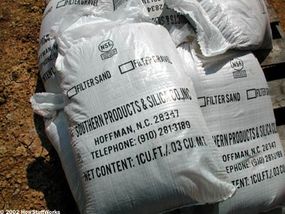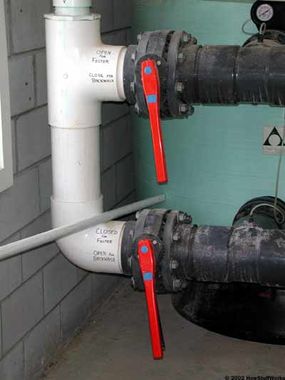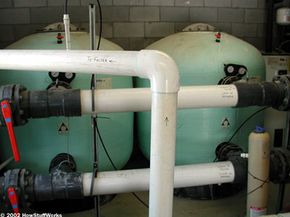Pool Filters

The filters in this system are high-rate sand filters. Sand filters consist of a large tank, made of fiberglass, concrete or metal, containing a thick bed of special-grade sand, which has a squarish shape.
During filtering operation, dirty water from the pool comes in through the filter's inlet pipe, which leads to the water distribution head inside the tank. While gravity pulls the water down through the sand, the tiny sand particles catch any dirt and debris. At the bottom of the tank, the filtered water flows through the pick-up unit and out the outlet pipe.
Advertisement
Over time, the collected dirt and debris in the sand slows down the water flow. Pressure gauges at the filter inlet and outlet give the pool custodian an idea of the blockage level inside. If gauges show much greater pressure on the inlet pipe than the outlet pipe, the custodian knows there's a lot of collected debris in the sand. This means it's time to backwash the filter. To backwash, the custodian adjusts a number of valves to redirect the water flow. He or she closes the return pipe leading to the pool and opens the drainage pipe, which lead to the sewer system. He or she adjusts a valve at the filter to connect the pipe from the pump to the outlet pipe and connect the drainage pipe to the inlet pipe. With this arrangement, water from the pump pushes up through the sand, dislodging the dirt and debris. At the top of the filter tank, the dirty water flows out through the inlet pipe and into the sewer.

In place of a sand filter, some pool systems use a diatomaceous earth filter or a cartridge filter. In a diatomaceous earth filter, water from the pool passes through filter grids coated with diatomaceous earth, a fine powder made from the chemically inert, fossilized remains of sea organisms called diatoms. In a cartridge filter, dirty water passes through a filter made out of polyester cloth or corrugated paper. Instead of backwashing, you simply remove the filter and hose it off. After a few years (or as many as eight years), it's time to discard the old filter and put in a new one.
In most regions, the law dictates that all the water in the pool (or more accurately, the equivalent volume) must pass through the filter in a certain amount of time -- typically between 30 minutes and six hours. For the apartment-complex pool pictured above, that means pumping 167,000 gallons (630,000 liters) of water through the filtering system every six hours!
The pump and filter system is also connected to a well or municipal water line so fresh water can be added to the pool. This is necessary to replace water lost to evaporation, backwashing and "splash-out" (water that splashes on the deck or is carried out on people's bodies and swim suits). When it's pretty hot out and there's heavy swimmer activity, this 167,000-gallon pool could lose 300 gallons (1,100 liters) or more in one day.
Next, we'll look at the chemicals at work in a typical swimming pool.
